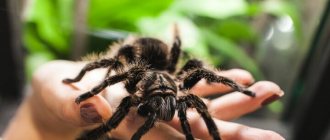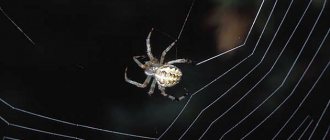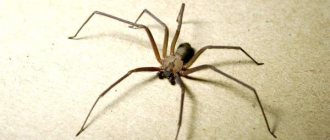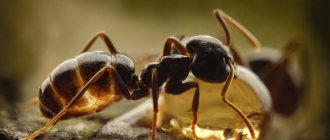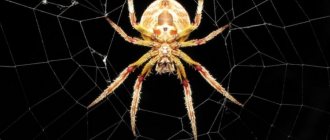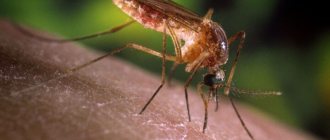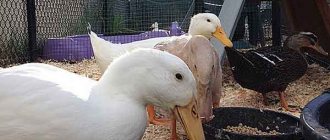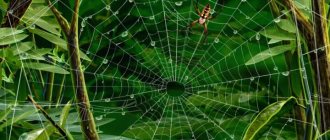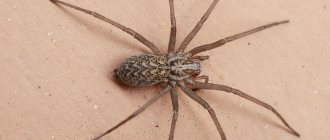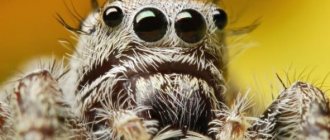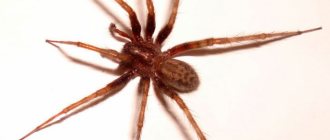4.8
Average rating: 4.8
Total ratings received: 179.
4.8
Average rating: 4.8
Total ratings received: 179.
Animals that are not insects, but were their predecessors in the evolutionary process, are arachnids. This article will help you understand in more detail how this class differs from other representatives of arthropods.
Signs of arachnids
Differences between arachnids and other classes of animals can be found in both the external and internal structure of the body. The external distinctive features of arachnids are:
- Absence of antennae and abdominal limbs;
- The body consists of two sections: the cephalothorax and abdomen;
Individual units of this class have their own characteristics of body structure. For example, a spider has two sections: the cephalothorax and abdomen. The scorpion has a cephalothorax, an anterior abdomen and a posterior abdomen. In mites, the body merges into one section.
- On the cephalothorax there are two pairs near the oral limbs (chelicerae and pedipalps), as well as four pairs of walking legs;
- Terrestrial way of existence.
Fig.1.
External structure of the body Distinctive features in the internal structure of the body include:
- The presence of glands that produce cobwebs, with the help of which some species hunt;
- The eyes have a simple structure;
- The respiratory system is presented in the form of tracheas and pulmonary sacs;
- The excretory system works using the Malpighian vessels;
Digestion partly occurs outside the animal's body. The spider injects poison into the victim caught in the web and wraps it tightly in the web. Under the influence of the poison, the soft tissues of the prey dissolve. After a while, the owner of the web returns and sucks out the nutrient fluid.
This class is one of the many species of animals that are distributed everywhere. The main and well-known examples of arachnids are scorpions, spiders, and ticks.
Internal structure
The internal structure of the spider has the following features:
- the spider has no skeleton. Muscles are attached to a collection of empty and tissue-filled cavities.
- External digestion of food.
- The spider does not hear sounds, but it is able to sense air vibrations.
- There are organs that are responsible for the formation of the web.
- Instead of blood, hemolymph circulates throughout the body. It contains copper and can be poisonous to some other animal species.
Endoskeleton
Inside the body there is a whole system of different organs that will serve as the spider’s skeleton.
They are called endoskeleton. It consists of the following parts:
- apodem. Empty cavities that serve to attach muscles. A small depressed area is located in the center of the cephalothorax. It is to this that the sucking ventricle is attached with the help of muscles. There are several other small epidemics that are needed to connect the spider's muscles to the exoskeleton. Outwardly, they look like long stripes that run along the entire body of the animal.
- Entosternum. In structure and functionality it resembles an apodeme. Only the cavities to which the muscles are attached are filled with tissue similar to cartilage.
- Apophysis.
Nervous system and sensory organs
The nervous system is one of the most important components in the anatomy of a spider. It is she who transmits signals from receptors to the brain - the main organ that is responsible for the functioning of the entire body. It is located at the bottom of the prosoma.
It consists of upper and lower parts. The upper brain is responsible for processing information received from the senses. The lower brain is large.
It gives commands to the musculoskeletal system. It is in it that instincts and reflexes are formed. Also inside the brain are glandular bodies that are responsible for the production of hormones.
Nerve threads extend to all organs inside the cephalothorax. And only one of them goes into the abdomen through the stalk.
The following sense organs can be distinguished that help arthropods navigate in space:
- eyes. At the beginning of the cephalothorax, above the chelicerae, there is a small mound. It is on it that several pairs of eyes are located. Spiders have poor eyesight, and therefore the eyes are not their main sense organ. A large number of species are nocturnal or burrowing, so they practically do not rely on vision.
- Hairs. Located throughout the body. Most of them are associated with nerve endings. With the help of hairs, animals are able to detect vibrations in air and soil, smell and identify objects. One touch is enough for the spider to understand that it is food in front of it, and not something inedible.
- Taste buds are located on the walls of the pharynx.
- Lyre-shaped organs. These are small cracks covered with a thin film. They are filled with nerve endings and are found on the legs of the arthropod.
- Tarsal organs. They are located on the pedipalps and the first two legs.
Digestive system
In spiders, the structure of the food system is due to the fact that their digestion of food occurs outside the body. The oral opening is located in the front of the cephalothorax between the chelicerae. The esophagus tube comes from it.
Through it, food enters the sucking ventricle. Through a short tube it is connected to the true ventricle. From here extends the small intestine, which goes through the stalk into the abdomen. The rectum ends with the anus.
The abdomen contains the Malpighian canals. These are thread-like organs of a spider that perform the same function as the kidneys in humans.
Using its fangs, the spider pierces the skin of the victim and injects gastric juice under it. The digestion process begins. The victim's tissues turn into a nutritious liquid. By contracting the sucking stomach, the spider draws food into itself.
With the help of stinging hairs on the chelicerae, it filters out large particles. Afterwards the food enters the true stomach. Partially digested, it rushes into the intestines. After the digestion process is completed, all remaining food and salt leave the body through the anus.
Circulatory and respiratory system
The spider's body is filled with a special liquid - hemolymph. The heart is located in the back of the abdomen. Outwardly, it looks like a long tube. The heart is placed inside a special cavity - the pericardium. The pericardium is equipped with a large number of nerve fibers.
It is they who cause the ligaments to contract, due to which hemolymph circulates throughout the animal’s body. There are four holes in the heart that act as valves.
Blood vessels run from the heart throughout the body. Arachnids have an open circulatory system. With each contraction of the pericardium, hemolymph rushes in several directions at once: forward, backward and to the sides. Hemolymph is capable of carrying oxygen throughout the body. Afterwards it seeps back into the vessels.
The spider has two pairs of lungs. They are located in the anterior part of the opisthosoma, not far from the cephalothorax. They consist of thin plates in which oxygen from the external environment replaces carbon dioxide.
Spiders
A feature of spiders is the presence of modified abdominal limbs - arachnoid warts. The secret of this gland quickly hardens in open space. With the help of cobweb threads, the animal builds a trapping network. Moreover, it consists of sticky and non-sticky threads. The victim, stuck to the web, is unlikely to be able to escape. The spider descends towards her along non-sticky threads to inject poison, which acts as digestive juice. The hairs on the body are of primary importance in the structure of the body; they play the role of organs of touch.
TOP 4 articles
who are reading along with this
Arachnids
Arachnid legs
Scorpio (arachnid)
Representatives of the Arachnida class
Rice. 2. Construction of the web
The importance of arachnids in nature and for humans
All living beings have their role.
Arachnids are part of the food chain. They themselves feed on small insects and often help people fight pests. The representatives of the family themselves also become food for larger individuals of their genus, arthropods, amphibians and various animals.
Some are enemies of man:
- spiders bite, causing pain and even more serious consequences;
- ticks are parasitic and carry various diseases;
- Scorpions prefer not to touch people and live separately, but if they get into a home or on things, they sting very painfully.
Ticks
Representatives of the order live not only in the environment, they can live in the body of an animal or human, in soil, and plants. Many of them harm agriculture, destroying cultivated plants. Ticks are also dangerous for humans, as they cause various diseases - scabies, encephalitis. But there are types of mites that are beneficial. These are mainly those that live in the soil. With the help of waste products, they fertilize it and participate in the process of formation of fertile soil.
Fig.3. Types of arachnids
Reproduction
Spiders are dioecious animals. Their genitals are located on the lower part of the abdomen. Males from there collect sperm into the bulbs at the ends of the pedipalps and transfer it to the female’s genital opening.
In most cases, sexual dimorphism of spiders is present. Males are usually much smaller than females, but are brighter in color. They are more interested in reproduction, while females often attack suitors before, after and during mating.
The courtship of some species of spiders is a separate form of art. For example, the tiny peacock spider has invented an entire dance that shows the female his intentions.
Test on the topic
- /10
Question 1 of 10The predecessors of insects are...
Start test
Hall of Fame
To get here, take the test.
- Seryozha Mantserov
6/10
- Valentin Muravyov
8/10
- Max Nefediev
4/10
- Vanya Shevchenko
10/10
Classification
There is no uniform classification system for spiders. One can only correlate their specific types by density of distribution, rarity of a particular species, safety or threat to human life, and size.
Safe spiders
This species includes representatives of the animal world that do not harm people. They are either unable to bite through the skin at all, or their venom does not pose any threat.
These arachnids include:
- crosses;
- tarantulas;
- haymakers (mowers);
- horses;
- brownies.
Cross spider
Deadly poisonous
In most cases, spiders do not pose any threat to humans. Especially if you don't try to deliberately anger him. But there are also those with whom it is better not to meet.
Arachnids that are truly poisonous and dangerous:
- karakurt;
- black Widow;
- Brazilian Runner Spider;
- banana spider;
- brown recluse.
Brown recluse spider
Rare
Some spiders can be found everywhere, while others are very rarely seen.
Such distinctive arthropods include:
- nephila-goldweaver;
- baboon spider;
- Sydney Spider Funnel Web;
- Colombian purple tarantula;
- phalanx spider;
- giant crab.
Golden spider
Little ones
Like all representatives of the animal world, spiders tend to vary in size. And if large arthropods evoke fear and disgust, then baby spiders can even evoke tenderness.
These babies include:
- anapistula;
- patu digua;
- side walker;
- Kipling's Bagheera;
- Abacarus histrix.
Sidewalk spider
Large
And next to these little ones live real giants who are impossible not to notice.
Particularly large species:
- tarantula Theraphosa Blonda;
- nephila orb weaver;
- tarantula;
- giant crab;
- banana spider.
Tarantula
Interesting Facts
Some people are very afraid of spiders, others simply adore them and keep them in the house as a cute pet. In any case, the attitude towards arachnids is ambiguous.
Here are some interesting facts about these distinctive animals:
- The usefulness of arachnids cannot be overestimated. One individual is capable of destroying about two thousand harmful insects per year.
- The largest arachnid known to science is the goliath. Its dimensions reach 30 centimeters. The hairs on its body are poisonous, but the poison is not fatal to humans.
- It turns out that not all arachnids are predators. There is also a peaceful vegetarian spider. And his name is Bagheera Kipling. He moves by jumping and eats plant leaves; his favorite food is acacia. Sometimes it can eat an ant larva by mistake.
- In the 15th and 16th centuries in Italy there was a belief that if a person was bitten by a tarantula, he would become insane. However, later scientists realized that the tarantula is absolutely harmless, but the tarantula is dangerous.
- Arachnids are distributed throughout the world. They cannot be found only in Antarctica.
- The spider thread of Darwin's arachnid has the most durable properties. It is even stronger than the material from which body armor is made.
- At one time, the spider is capable of laying several thousand eggs. But few creatures survive to maturity. Out of a hundred eggs, only one spider survives.
- The most poisonous arachnid known to science is called the Brazilian banana spider. Its poison can paralyze the human respiratory and muscular systems.
- Arachnids show miracles of resistance against radiation. They can easily tolerate such a level of radiation, even a thousandth of which is dangerous for humans.
Brazilian banana spider
What structural features of ticks and spiders indicate their similarity?
Although ticks and spiders have some similarities, it is quite easy to distinguish them from each other.
For example, they have similar characteristics, belong to the same class - arachnids, and arachnology studies them in detail. This pair of close “relatives” has many similarities. Reference. The main distinguishing feature of ticks and spiders is their body structure.
It consists of a pair of sections: the abdomen and the cephalothorax. The main similarities between ticks and spiders are four pairs of legs and simple eyes.
Habitats
Spiders live everywhere on our planet. They are only absent where the earth's surface is covered with ice blocks all year round. The largest number of arachnid species live in the humid tropical zones of the equator. Arachnids make their homes on the ground, underground, in trees, among grasses and bushes. Any cracks and cracks are suitable for their existence. There is even one unique representative of arachnids that makes its home under water. This is a silverback spider. The structure of its body is ideally suited for living in an aquatic environment.
The tarantula spider prefers to nest in the crown of trees. This is due to his diet. After all, where is the easiest way to catch a bird, if not on a tree?
The most unpleasant place for a spider to live is, of course, human habitation. Few people will encounter this furry-footed animal on their territory without trembling. Nevertheless, a wide variety of arachnid species can be found in an apartment, from haymaking spiders to phalangoid folcus.
Arachnids that feed on insects prefer to live in grassy meadows, bushes, among fallen leaves and under stones. Places of high humidity are most preferable for them. One of the brightest representatives of these types of arachnids is the wolf spider. By the way, he is one of the most frequent guests of our gardens and vegetable gardens. A distinctive feature of this animal is that it does not weave a web and looks very much like a smaller copy of a tarantula.
In the sands of South Africa and South America you can find the sand six-eyed wanderer arachnid. This spider resembles a crab in appearance and spends its time buried in the sand. This is how he waits for his victims.
